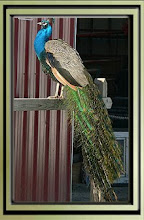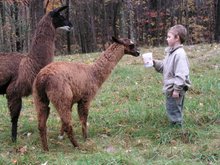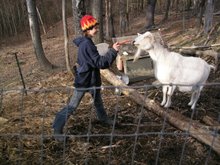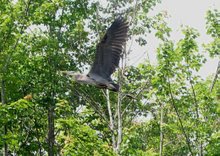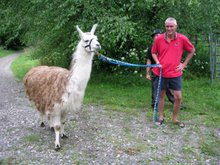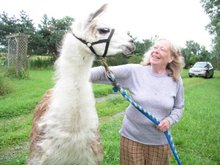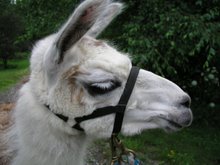I've spent the last few weeks catching up on reports, license renewals, rehab logs, etc. My individual Wildlife Rehabilitation Log for the DEC is 40 pages of wild birds, mammals, reptiles and amphibians. My RVS intake forms for the 40 raccoons, 10 skunks and a dozen bats are over 30 pages. This year alone, my log alone has over 200 wildlife entries. Add my wife's squirrels, and what our BOD and Associated Rehabbers in our network have done, I would not be surprised at all if the total for our group is well over 500 wild animals saved this year. It is NOT a contest to see how many animals I can save. I just do what I can do and we try to do things first class not half-assed, one animal at a time. Add in our domestic pet rescues, livestock and exotic animal rescues ... wow, no wonder I'm so tired lately. Being a perfectionist, I was complaining to a friend the other day about how much more I could do and was thinking out loud about how many more animals I could save. I often wonder if I am making a difference in the world ... maybe not, but as my friend pointed out, I make a big difference to the animals and kids I help. I do know that we wouldn't have a website and a lot of paperwork wouldn't have gotten done without the help of my very good friend Gayle Nastasi, visit her website from our links, it is great and she is very talented. I am lucky to have her as a friend and on our BOD.
When I was trying to figure out what to write about tonight, I figured I would start with my standard apology for not blogging. I don't want to do a reflection on the year (yet), but looking back over the last year ... we have accomplished more than many of the animal rescue facilities that have large budgets, with taxpayer support and paid staff members. I am very proud of what we have done. If I can keep up with fundraising, facility construction, rehabbing the animals, public relations, paperwork, my job teaching, my family and my wife ... we are going to build a facility here that will be second to none and will long outlive me.
In November I attended a NYS Falconers Banquet. It was a fun time, I bid on some great items in the secret auction. Unfortunately I didn't win any of it but hey, all it takes is a dollar and a dream. Also in November, I went to the NY Wildlife Rehabilitation Council's Conference in Lake George. It was a great conference, lots of great friends, food and drink (it is my vacation also). I went to as many of the classes as I could that were on Raptors. As always, I really learned a lot and it was well worth attending. Networking is half the battle of being a good rehabber. I got to see and meet a lot of great Wildlife Rehabbers at the conferences and I learn a lot over a few drinks. I really want to encourage EVERYONE to take the test and become a wildlife rehabilitator. Remember that becoming a rehabber is one of the most rewarding things you can do. You can put as much time into it as you can afford (mentally and financially) and say no when you are in over your head. The demand is huge for new rehabbers, I believe that there are only a couple of dozen licensed RVS Rehabbers that can legally do raccoons, skunks and bats in the entire STATE of NY. My wife is like most rehabbers, she found her niche, she only does squirrels. Some rehabbers only do rabbits (only have to be fed twice a day). Some only do baby birds, every 20 minutes ... yikes.... The key to being a good rehabber is having a good mentor. If you are interested in doing this crazy thing of saving wild animals, you MUST get a good mentor. A good teacher is better than any book and you will burn out if you don't get taught right and stay on the cutting edge in new techniques for giving animals (that often want to die) some life. I've had one of the best mentors; Kelly Martin has done this for over 20 years. She is President of NY Wildlife Rehab Council and she is one of the best rehabbers that I have ever met. You can go to DEC's website, order the study materials, enroll to take the test but it is almost impossible to figure out what license you need for what animals. It is impossible to keep track of renewals, applications and logs. I am the most organized person that I ever met and I often say "I need another license for that?" or "When is that form due?" or "No wonder why no one does this...." :) A good mentor is very important to show you how to do it right and keep your sanity in the process.
I have done my required hours working with Kelly, I have the hundreds of hours needed and have received my US Fish and Wildlife Federal Migratory Bird Rehabilitation Permit now. Kelly is a great teacher, she lets me learn some things on my own and then smiles when I figure it out, she often puts on her glasses when I now know I am going to see something new, she gives me a kick in the ass when I need it or am in need of a pep talk. I am waiting to receive my own Federal Special Purpose Migratory Bird Educational License. I will be learning how to rehab animals better for the rest of my life, it will be nice to be done collecting licenses.
Kelly lost a very special Raptor this week that anyone that has ever seen our educational shows knows well. Hooter the Great Horned Owl was one of Kelly's first educational raptors, added to her federal license in 1985. Hooter would go anywhere, would sit on your fist forever and was always the bird that never got off his stand, rarely gave us a hard time ... just the dream bird that will be missed greatly by all. I'm sorry for your loss Kelly.
Enough for tonight.





